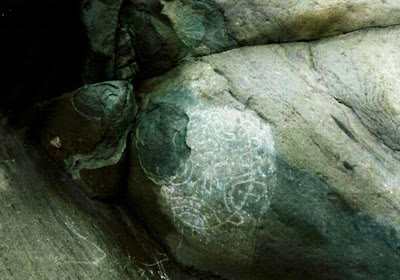Cliffs and hoodoos at Writing-On-Stone
Provincial Park, Alberta, Canada.
Photo. Peter Faris, June 25, 2016.
On June 25,
2016, I had the opportunity to visit a world-class rock art site,
Writing-On-Stone Provincial Park, Alberta, Canada. Sitting in the valley of the
Milk River, this magical area of cliffs, hoodoos, and petroglyphs, was sacred
to the Blackfeet people and still evokes an aura of mystery in the mind of a
visitor. There is much more rock art here than a person could expect to see in
a number of days so I did not resent the fact that the guided tour skipped a
number of sites that we could see as we drove by. I still filled the time
available with visiting, photographing, and appreciating some remarkable rock
art.
Rock art at Writing-On-Stone
Provincial Park, Alberta, Canada.
Photo. Peter Faris, June 25, 2016.
Although I
would not trade this opportunity to visit Writing-On-Stone for the world I must
admit to a couple of disappointments with it. First, the sky was an even
overcast gray diffusing the daylight and making photography very difficult.
Although I do know that I took pictures of rock art I cannot now find the rock
art in some of the pictures that I did take. We all know how the lighting
affects rock art photography, and this day was one of the more extreme I have
had to put up with. I saw the petroglyphs while I was there, but they do not
show up in some of the photographs.
Mitigated cliff at Writing-On-Stone
Provincial Park, Alberta, Canada.
Photo. Peter Faris, June 25, 2016.
The second
disappointment regards an attempt made to mitigate vandalism to rock art
panels. Over the years since the discovery of the site by Anglos people have
been adding their names, initials, dates, etc., to the rock art panels. This is
the all-too-common vandalism the we see on most known rock art panels. This
mitigation was done by removing the inscription, with a hand wielded dental
pick in instances where prehistoric rock art might be affected, to grinding the
inscriptions off the rock face with a steel-bristled brush, sometimes held in a
rotating electric drill. This was done because there was concern that the
vandalism would negatively impact on their application to become a UNESCO World
Heritage Site, so they had it removed. Hired workers and volunteer crews between
July 26 and August 10, 2012, removed graffiti from 47 panels, and between September 13 and September 21, 2012,
they removed graffiti from a further 47 panels, 94 panels in total were
affected.

Mitigated cliff at Writing-On-Stone
Provincial Park, Alberta, Canada.
Photo. Peter Faris, June 25, 2016.
Once the
graffiti had been chipped or ground off the work area was camouflaged by painting
colorants back onto the surface to mimic the patina of the rock face. Colorants
used were natural pigments collected in the area, yellow ochre from a rock
shelter in the area, red ochre from nodules found on the ground beneath the
cliff faces having weathered out of the rock, and for grayish tones charcoal
from local vegetation. These colorants were finely ground and mixed with water
from the milk river and then brushed onto the surfaces to emulate the untouched
rock surfaces nearby.
These
techniques were of limited success as by the time of my visit the camouflaging
colorants were obviously washed off by weather and the graffiti removal scars
stood out as large light-colored, smooth areas very noticeably different from the
natural rock surface. Personally, I dislike this technique greatly, I would
rather see good, honest initials and names "defacing" the rock face
than these large smooth unnatural-looking scars.
Damaged prehistoric petroglyphs
at Writing-On-Stone Provincial
Park, Alberta, Canada. Photo.
Peter Faris, June 25, 2016.
Even more
disturbing to me is the fact that in many cases prehistoric petroglyphs were
damaged by the removal of overlying graffiti. I have a number of photographs
that illustrate this damage (although as I said above they are very difficult to see because of the lighting). Even sillier to me is the fact that staff had gone
to some effort to compile a list of the inscriptions that had historical
significance, i.e. early explorers and settlers, that they stipulated should be
left alone while other graffiti was to be removed whenever possible. Had they
just waited, the passing of time would have given the later inscriptions
historical significance as well. Remember, all that history is, is what
actually happened, and they had actually happened. A prehistoric petroglyph
carved over an earlier prehistoric petroglyph was vandalism when it happened.
Be that as
it may, this is now also a part of the history of Writing-On-Stone, a
lamentable part to be sure, but a part. No matter what else it is,
Writing-On-Stone is still a world class rock art site and should not be missed
if the opportunity to visit it comes up. And now it can also be considered an educational
site that displays a number of what I consider to be mistaken assumptions about
what an authentic rock art site is, and should be. Please world, if anyone out
there is listening, please do not replicate these techniques elsewhere.






































